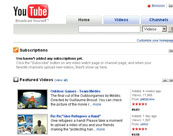
After more than 35 years of operation, TBI is closing its doors and our website will no longer be updated daily. Thank you for all of your support.
YouTube experimenting with pay TV EPGs
 YouTube is starting to experiment with making its channels available on IPTV operators’ EPG as part of partner-led initiatives to extend the platform and keep viewers engaged.
YouTube is starting to experiment with making its channels available on IPTV operators’ EPG as part of partner-led initiatives to extend the platform and keep viewers engaged.
Speaking at Mobile World Congress in Barcelona, YouTube’s global director of mobile and platform partnerships, Francisco Varela, said that the video site is working with operators in a bid to offer a seamless experience and is giving more priority to playlists.
“On IPTV we started some initiatives where YouTube is part of the EPG guide. If you’re a subscriber to a channel on YouTube, why shouldn’t it just show up as channel 206 on your TV guide? We’re seeing some very exciting initiatives being partner-led, and that’s where I think we’re going to continue to thrive as a platform,” said Varela.
Discussing APIs and curation, he said that adjustments to the site that rolled out last week would help engagement, putting more focus on YouTube Playlists and making it easier for users to edit playlists they’ve created.
“We’re not saying that we’re the be-all and end-all of curation,” said Varela. “We’re giving some priority over playlists to keep folks engaged in curation that is already taking place by some of our users.”
He added that YouTube is also offering these same tools to operator partners: “What’s going to lead a Telenor user is going to be very different than what leads in a Vodafone user in Germany. We’re giving our partners the ability to curate for themselves.”
In terms of content delivery, Varela said that the Google-developed VP9 video compression codec will help make its data more efficient through the pipe – “whether it be Comcast in the US or BT in the UK.”
“Going forward, we want to be a great partner in the mobile ecosystem and even fibre,” said Varela, claiming that YouTube is investing in codecs to help meet the issue of demand, with 100 hours of YouTube content now being uploaded every minute and a billion people accessing the service every month.
“How do we make that content come to you much more quickly? There’s no predictor better about whether you’re going to watch another video on YouTube than how quickly you received that first video. If you received it quickly and in good quality, we’re pretty sure you’re going to watch another video. So we need to be a better partner in that ecosystem and VP9 is a big step towards that,” said Varela.


